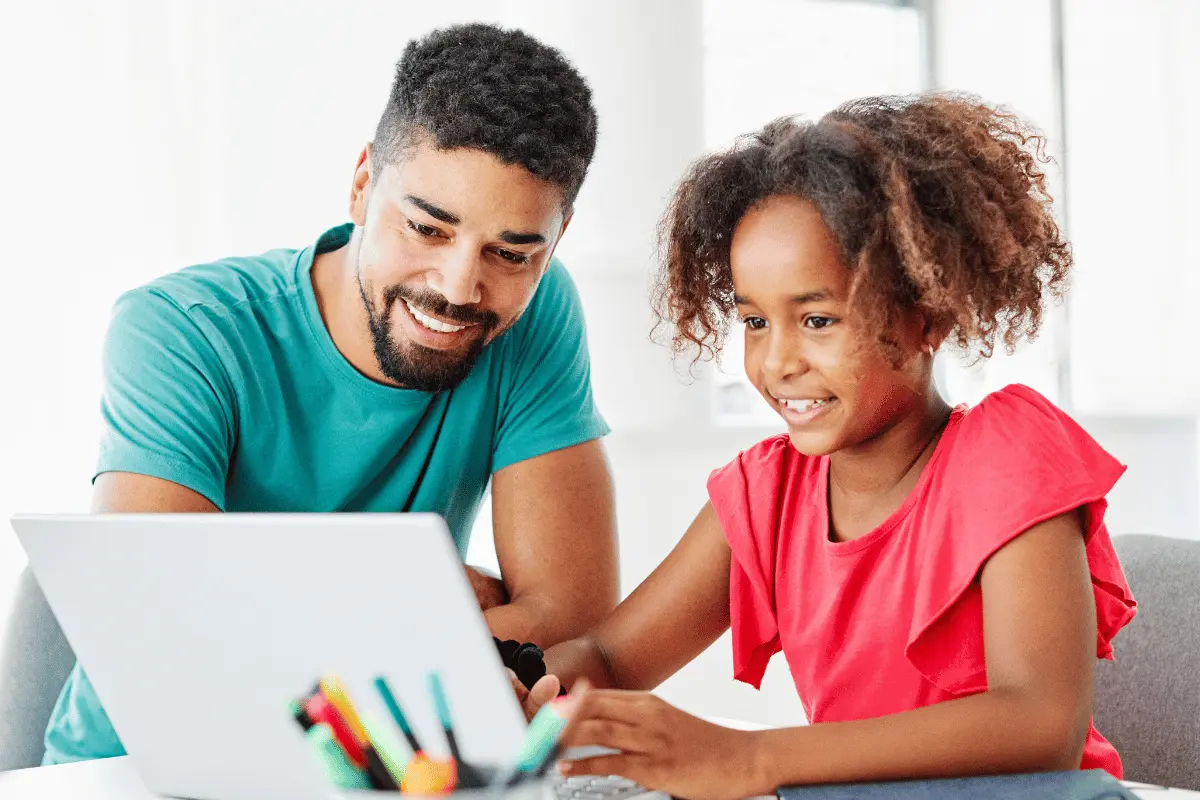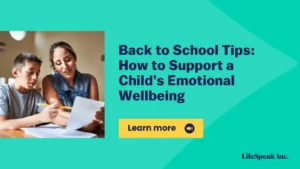As October ushers in Emotional Wellness Month and families settle into the back-to-school routine, many parents are looking for guidance on how to help kids with anxiety as they adjust to new environments and challenges. To support families during this time, LifeSpeak expert Jennifer Snowdon, a trauma-informed Yoga Teacher and Buteyko Breathing Educator, offers valuable insights and strategies for managing anxiety in both children and adults. Whether your child is navigating a new school year or you’re looking for ways to support emotional wellbeing at home, Jennifer’s expert advice can help you reframe anxiety, build resilience, and foster emotional health for the entire family.
What is anxiety?
Anxiety is a possible response to stress. It’s a feeling that says we don’t know what’s going to happen, we are uncomfortable with that uncertainty, and we are afraid. Kids have less experience of the world and less control over what happens to them, which might lead them to feel great anxiety. Here are some ways to talk about anxiety with the kids in your life and how to help them overcome anxiety. These ideas may even help some adults, too.”
How to help kids with anxiety:
Reframe and refocus
If we plot emotions on a graph, we could say that we have four quadrants, defined by the amount of nervous system activation (high energy or low energy) and by the amount of fear we feel (afraid or safe). Anxiety would fall in the quadrant of high energy and fear. Interestingly, there are other emotions that we feel that are also activating, like excitement, delight, or astonishment. The difference between these is whether or not you also feel afraid. Anxiety and excitement might feel very similar in the body — butterflies in your stomach, sweaty palms, jittery, and hard to sit still.
Sometimes, reframing anxiety as excitement can be really helpful:
You have a presentation tomorrow? That’s really exciting!
You’ve been chosen to be the lead in the school play? That will be fun to prepare for.
You’re going to start at a new school tomorrow. Meeting new people will be really interesting.
“Kids have less experience of the world and less control over what happens to them, which might lead them to feel great anxiety.”
You can show kids where emotions sit in this graph — of course, someone else might experience an emotion in a different way, with more or less energy, for example. An activity to do with kids could be to draw a circle with four quadrants and ask them where their emotions currently are and where they would like to be. Bringing some clarity and language to what they are experiencing and helping kids recognize that they have some measure of control over their own experiences can be empowering.
The biggest difference between anxiety and excitement is fear. Fear of what? Often, that fear is about what other people will think or do or say. Sometimes the fear is over an outcome. It can be helpful to refocus the object of the emotion — instead of thinking about the outcome, turn your attention to the intent or effort. When we put our focus on an effort to be kind to new people, we’re more likely to make new friends than if the focus is on whether or not people will like us.
Let go of fear
Sometimes it can be hard to let go of the fear part of our anxious feelings. It can be helpful to understand that fear is attached to our possible future experiences. We’re not afraid of what is happening right now but of what might happen later. That’s really important. It’s not fear of what will happen because we honestly don’t know exactly what will happen. We might think that a teacher will be angry with us because we didn’t get our homework done, but that teacher might be willing to grant an extension if they are asked. We are afraid that people will laugh at us if we ask a question, but they might just answer it with no emotional reaction.
Of course, our predictions about the future are based on our past experiences, and fear as a survival mechanism has kept humans alive for all time, but our fear alarm is on overdrive right now, and it’s going off when it doesn’t need to. It’s good to notice when we are afraid, find out what that’s about, and then do something about it so that we can stop feeling scared. Fear is a signal to act. We need to make smart decisions, and that’s what fear reminds us to do. When we do the things that our fear reminds us to do, we can let go of the emotion. Notice the sign and follow its instructions, but don’t pick it up and carry it around with you.
“Fear is about the future, and if we stay in the present moment, we will feel less afraid.”
It’s a good reminder that fear is about the future, and if we stay in the present moment, we will feel less afraid. Practice being present. Notice the world around you — what are your senses telling you? What do you see, hear, or smell? Work on solving a puzzle — getting out a jigsaw puzzle and working on it together can be fun. Work at being in the moment as much as possible. When you wash the dishes, wash the dishes. When you walk the dog, walk the dog. When you talk to someone, just talk to them. If we don’t work at learning to be present, if we are always escaping from the present, it’s harder to be present when things are tough. Turn the TV off, put your phone down, log off social media, and just be for a period every day.
Reconnect
Johann Hari wrote a book in 2018 called Lost Connections. He wrote it about depression, but he also says in it that depression and anxiety are two sides of the same coin, two different responses to the same thing. When we reconnect, we find that depression and anxiety lessen. He talks about reconnecting to other people, to meaningful work, to nature, along with many other things and ideas. Think about how you can teach your kids meaningful connections to the world around them. How can you model that for them? Maybe start by connecting with kids in meaningful ways and help them make meaningful connections with other people. Get outside and learn about the environment where you live. What are those trees, and which birds do you see or hear? Is there something that you can do to make the environment better — a community clean-up day or maybe a bird feeder for the backyard? Have you ever built a bat house? When you learn about nature and engage with it, you work at being present and connected in real ways that make feeling anxious more difficult.
Build Resilience
Fear is uncomfortable. What do you do when you are uncomfortable? Teaching kids that discomfort is okay makes them more resilient in many ways. There is a video out there of kids in Russia snow-bathing. They get in a sauna and get really hot, and then they all run out into the snow in their underwear, pour water over each other, and roll around in the snow. It’s uncomfortable to be really hot or really cold, but they practice doing it and experience that it’s not as bad as they thought it might be. Can you be present with discomfort? Can your kids? What happens when they are bored? Learning to be okay with boredom, cold, and heat can make the unknown less difficult.
We can also build resilience by learning new things and challenging ourselves. How many different ways can you learn? You can physically learn a new thing, like how to move your body in a different way (dance, yoga, martial arts). You can also learn a new skill, like playing the piano, knitting, or baking. Learning a language can challenge your brain. It might be Spanish or HTML5. All of these things can build resilience. The more resilience we build, the more we know we are capable of managing new things and the less anxious we feel about what could come down the pike.
If we can think about our emotions in new ways, practice being present and connected, and learn to build resilience in ourselves and our kids, we’ll be better equipped to handle the whole range of emotional responses to situations that come up for us with strength, presence, and grace.
Managing anxiety—whether in children or adults—requires a compassionate and mindful approach. By reframing anxious feelings, staying present, and fostering resilience through small, intentional actions, we can help ourselves and our kids navigate life’s uncertainties with greater confidence. During Emotional Wellness Month and beyond, it’s important to nurture our emotional wellbeing, not just in times of stress but as a continuous practice. With the right support, like the insights shared by LifeSpeak expert Jennifer Snowdon, we can create a healthier, more balanced life for ourselves and our families.
Looking to equip your employees with the tools they need to support their families’ emotional wellbeing and manage anxiety during challenging times?
LifeSpeak’s whole-person wellbeing solutions offer your employees and their families access to an easily accessible library of resources, including expert-led content on mental health, mindfulness, parenting and caregiving, financial literacy, and more.
Book a demo today.
 About the author, Jennifer Snowden, Yoga Teacher and Buteyko Breathing Educator
About the author, Jennifer Snowden, Yoga Teacher and Buteyko Breathing Educator
Jennifer Snowdon is a Yoga Teacher and trauma-informed Buteyko Breathing Educator. Bringing together the traditions of yoga, the science of breath and body, and the understanding of the nervous system and trauma, she helps people move, breathe, and live more present and connected lives.




